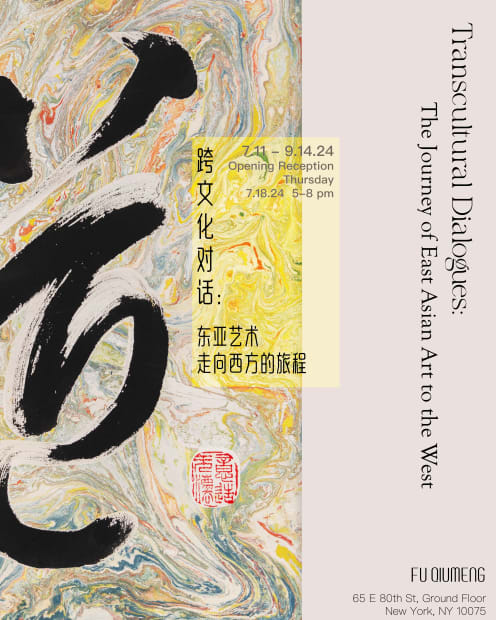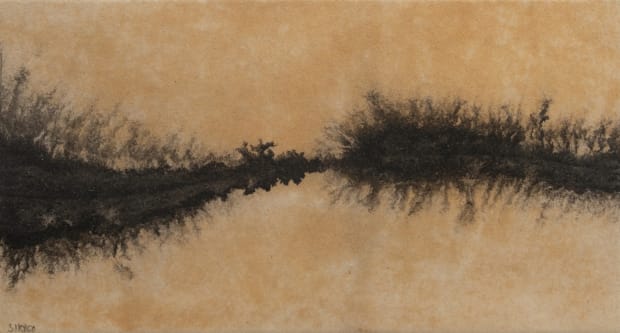-

-

-
-
THE ABSTRACT NATURE AND MODERNITY OF CLASSICAL EAST ASIAN ART
We first trace the abstract qualities and modernity in classical East Asian art, focusing on works rooted in the literati painting tradition, which is a distinctive form of Chinese art developed through the intellectual pursuits of scholars over the centuries. In 4th Century China, Zong Bing (375-443) and Wang Wei (414-453) laid the foundation for literati painting, emphasizing that landscape painting should express artists’ inner feelings rather than merely depict nature realistically. Xie He (5th century) established the “Six Principles,” further defining the core values of literati painting. Northern Song scholar Su Shi (1037-1101), through his appreciation of Wang Wei’s (692-761) works, stressed the integration of poetry and painting, gradually merging literati painting with poetry to create a unique art form. Yuan dynasty artist Zhao Mengfu (1254-1322) proposed that calligraphy and painting share the same origin, incorporating calligraphic techniques into painting and enhancing its abstract expressiveness. Ming dynasty artist Dong Qichang (1555-1636) absorbed Zen concepts and proposed the “Southern and Northern Schools” theory, further influencing East Asian art history.
-

With increasing cultural exchange, Western art gradually entered China from the mid-to-late Ming dynasty. Although Dong Qichang and his literati art contemporaries were not very interested in realistic painting, Western artists like Giuseppe Castiglione (1688-1766) and Jean Denis Attiret (1702-1768) had a profound impact on Qing dynasty court painting. Later, the decline of national power in the late Qing period led many scholars to question traditional aesthetic standards and turn towards Western realism. However, as time progressed, realism gradually waned in the West. In the wave of abstractionism, the interplay of yin and yang or emptiness and solidity in Chinese painting provided new inspiration for later artists. This exhibition begins with the works of the renowned late Ming monk-painter Bada Shanren (1626-1705), who elevated the xieyi (writing ideas or conceptions, freehand) style to new heights.
-

Bada Shanren 八大山人(1626-1705)
Harmony of Mandarin Ducks and Blooming Lotus
Ink on Paper, hanging scroll
65 1/4 x 29 1/4 in; 165.7 x 74.3 cm
-

Scholar’s Rock, Qing Dynasty (1644 - 1911),
White Taihu Limestone, Wood Stand
-
As groundbreaking and modern as Duchamp’s efforts may seem, a traditional Chinese artistic practice offers a serious precedent for the essential idea behind the readymade: that an object untouched from its original state can be selected by an individual and presented as art. This is the scholar’s rock, examples of which have been recorded back to at least the seventh century. Given that nature is the fundamental source of East Asian art, it is not surprising that individuals involved with aesthetic pursuits might enjoy the intriguing shapes and surfaces of stones and rocks one might come across. However, scholar’s rocks were specifically regarded as art objects, with standards of aesthetic evaluation. Indeed, by the tenth century, there were collection catalogues recording the most significant groupings of scholar’s rocks assembled by knowledgeable individuals – connoisseurs of rocks, as it were. Otherwise untouched, the scholar’s rocks were placed on specially carved mounts – like Western sculptures placed on pedestals – designed to accentuate each rock’s admirable characteristics. By the Tang dynasty (618–907), four principal aesthetic criteria -- thinness (shou 瘦), openness (tou 透), perforations (lou 漏), and wrinkling (zhou 皱) – had been identified for judging scholars' rocks. Like Duchamp’s objects, these rocks have been awarded the status of art, and not in a perhaps tongue-in-cheek manner, as Dada was wont to indulge in. But while Duchamp’s readymades and Chinese scholar’s rocks are both found objects, Duchamp chose products of manufacturing processes, items that were decidedly artificial; utterly different is the scholar’s rock, which is completely natural. Its appreciation reflects the profound centrality of nature to the Eastern concept of artistic production. Here the Eastern eye and mind are simply yielding before the expressive power of nature and its ability to create forms far beyond human skill or imagination.
-

-
-
HISTORICAL PERSPECTIVES ON EAST-WEST ART EXCHANGE
The exhibition transitions to the early 20th century and showcases the multiple facets of East-West art exchange, illustrating how Chinese artists sought artistic breakthroughs in the West while Western artists explored the value of traditional Asian art.
Modern period diaspora artists like Zhang Daqian (1899-1983), C.C. Wang (1907-2003), and Wang Fangyu (1913-1997) made significant contributions to introduce Chinese painting and calligraphy during this period. Upon their arrival to the new continent, they integrated Western influences into their works, creating unique styles. Simultaneously, the ink paintings of the renowned Chinese artist Qi Baishi (1864-1957) will also be featured. Notably, Isamu Noguchi (1904-1988), a pivotal figure in American modernism, studied Chinese ink art under Qi Baishi in the 1930s. This significant mentor-mentee relationship underscores the profound impact of East-West artistic exchange on the evolution of later Asian American art.
-

Qi Baishi 齐白石 (1864-1957), Standing Tall, Calling Far, Ink on paper, hanging scroll, 70 1/2 x 19 in; 179.1 x 48.3 cm.
-

Wang Fangyu 王方宇(1913-1997), Eagle, 1996, Ink on paper, hanging scroll, 52 x 31 3/4 in; 132.1 x 80.6 cm
-

Zhang Daqian 张大千 (1899-1983), Moonlit Lotus After the Rain, Ink and Color on Paper, hanging scroll, 54 7/8 x 26 in; 139.4 x 66 cm
-

C. C. Wang 王季迁, Lotus Elegance of the Double Ninth Festival, 1966, Ink on paper, hanging scroll, 37 x 70 1/2 in; 94 x 179.1 cm
-
-

Hanafusa’s “process paintings,” which represent a profound evolution from the artist’s earlier minimalist period, embody a mystical visual language rooted in his ecosophic worldview – a philosophy of ecological harmony or equilibrium. Concepts such as time, materiality, and process are foregrounded through the use of custom-made silver or golden aluminum paint, Hanafusa’s preferred material. Central to Hanafusa’s philosophy is the notion of uchuiden, the shared, latent memories of the cosmos that interconnect all human beings. This concept serves as the spiritual foundation of his Cosmic Inherent Memory (Uchuiden Kioku) series. Hanafusa articulates this concept with the following statement: “I didn’t do the work; Nature did it,” highlighting his collaborative approach with nature. At the methodological level, Hanafusa borrows nature’s power to express his unique understanding of materiality. In this series, water- and oil-based aluminum paints were brushed on the canvas and left to stratify under gravity. The paints flow and converge, drying with traces of bubbles and wrinkles on the canvas. This process-oriented method underscores the boundless possibilities in time and space, bridging the visible and invisible, the material and the spiritual, and reflecting his belief in the interconnectedness of all existence through the interplay of time and materiality.
-
 Brandon Sadler, Time, 2022, Enamel on Cotton-paper48 1/2 x 44 in; 123.2 x 111.8 cm
Brandon Sadler, Time, 2022, Enamel on Cotton-paper48 1/2 x 44 in; 123.2 x 111.8 cm -

Brandon Sadler,
Into the Sun, 2022. Ink on Xuan paper
28 1/2 x 56 1/2 in, 72.4 x 143.5 cm
-
“My project takes inspiration from the intricate and complex pathways carved by beetles on tree trunks.” - Cui Fei, 2024
Cui Fei is a Chinese American artist based in New York. This work represents the artist’s exploration of the asemic writing (written lines and symbols that look like writing, but have no meaning) found in nature. She created this sculpture using lead, woodworking techniques and found materials. While collecting plant materials in nature, she discovered that some of the markings left by beetles on the tree trunks closely resembled Chinese calligraphy. She then laid a sheet of metal onto the wood and delicately hammered to imprint the contours and textures of the tree trunk.
The artist traces "writing" back to its origins in nature, emphasizing the importance of nature to human civilization. The transformation of the natural wood material into a lifeless gray piece of lead also symbolizes the immense loss caused by our excessive exploitation of nature. This work serves as a poignant reminder of the urgent need for change for a sustainable future, awakening awareness through visual impact.
-
-
-
 Bada Shanren, Harmony of Mandarin Ducks and Blooming Lotus 鸳荷待画眉
Bada Shanren, Harmony of Mandarin Ducks and Blooming Lotus 鸳荷待画眉 -
 Zhang Daqian, Hidden Gems of the Pond 荷塘甘香, Undated
Zhang Daqian, Hidden Gems of the Pond 荷塘甘香, Undated -
 Fung Ming Chip, Black on Black Script, 2009
Fung Ming Chip, Black on Black Script, 2009 -
 Wang Fangyu, Dao
Wang Fangyu, Dao -
 Wang Mansheng, Sunset 夕陽, 2009
Wang Mansheng, Sunset 夕陽, 2009 -
 Zhang Daqian, Moonlit Lotus After the Rain 出浴荷光
Zhang Daqian, Moonlit Lotus After the Rain 出浴荷光 -
 Qi Baishi, Lotus of Longevity 荷花壽
Qi Baishi, Lotus of Longevity 荷花壽 -
 Qi Baishi, Standing Tall, Calling Far 立高声远
Qi Baishi, Standing Tall, Calling Far 立高声远 -
 Wang Fangyu, Eagle, 1996
Wang Fangyu, Eagle, 1996 -
 Arnold Chang, Mindscape: Omni-directional, 2011
Arnold Chang, Mindscape: Omni-directional, 2011 -
 Michael Cherney, Morrison, 2024
Michael Cherney, Morrison, 2024 -
 Cui Fei, Vermicular Calligraphy III, 2022-2024
Cui Fei, Vermicular Calligraphy III, 2022-2024 -
 Brandon Sadler, Breathing With the Sun, 2022
Brandon Sadler, Breathing With the Sun, 2022 -
 Sal Sirugo, CO-42, 1994
Sal Sirugo, CO-42, 1994 -
 Sal Sirugo, M-32, 1974
Sal Sirugo, M-32, 1974 -
 Sal Sirugo, M-175, 1972
Sal Sirugo, M-175, 1972 -
 Sal Sirugo, M-175, 1972
Sal Sirugo, M-175, 1972 -
 Hisao Hanafusa, Uchuiden Kioku - QM23, 2001
Hisao Hanafusa, Uchuiden Kioku - QM23, 2001 -
 Hisao Hanafusa, Uchuiden Kioku - QM24, 2001
Hisao Hanafusa, Uchuiden Kioku - QM24, 2001 -
 Hayoon Jay Lee, Moment III - Unlike, 2023
Hayoon Jay Lee, Moment III - Unlike, 2023 -
 Shen Chen, Untitled No.8013-14, 2014
Shen Chen, Untitled No.8013-14, 2014 -
 Wang Mansheng, Roots of Clouds 雲根集, 2021
Wang Mansheng, Roots of Clouds 雲根集, 2021 -
 Wang Mansheng, Collection of Rotted Wood 朽木集, 2019
Wang Mansheng, Collection of Rotted Wood 朽木集, 2019 -
 Hayoon Jay Lee, Moment IV, 2023
Hayoon Jay Lee, Moment IV, 2023 -
 Wang Mansheng, Late Autumn 深秋, 2009
Wang Mansheng, Late Autumn 深秋, 2009 -
 Ding Yanyong, Dew-Kissed Lotus at Dawn 菡萏晓露, 1965
Ding Yanyong, Dew-Kissed Lotus at Dawn 菡萏晓露, 1965
-
11 July - 19 October 2024
Join our mailing list
* denotes required fields
We will process the personal data you have supplied to communicate with you in accordance with our Privacy Policy. You can unsubscribe or change your preferences at any time by clicking the link in our emails.















































